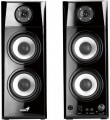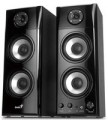Lines
The number of individual frequency bands played by the speaker. At least one specialized speaker is allocated for each such band.
The point of using multiple frequency bands is that for different frequencies, the optimal design of the speakers will also be different (for example, it is better to make tweeters small, and woofers large). Thus, dividing the sound into bands improves the sound. In turn, the advantage of
single-way speakers are compactness and lower cost.
Models for 2(LF / HF) or
3 bands(LF / MF / HF) are considered classic options for multi-band computer speakers. There are also
2.5 acoustics — it has 2 separate speakers for bass and treble plus a combined bass + midrange.
Sensitivity
Sensitivity characterizes the loudness of the speakers when a signal of a certain power is applied to them. The higher this indicator, the higher the volume will be with the same characteristics of the signal source; simply put, on the same computer and the same volume settings, more sensitive speakers will play louder.
In general, an indicator of 85 dB is considered good, 90 dB and above is excellent. On the other hand, computer speakers rarely need a very high volume — they are usually located close to the user and are designed only for him. So in general, this parameter can be ignored.
Impedance
The electrical resistance of the speakers to alternating current. This parameter is important primarily for normal compatibility with the amplifier: too low speaker impedance can lead to distortion, overload, and even damage to the speakers, and too high impedance can reduce the sound volume. At the same time, the vast majority of modern computer acoustics have their own amplifiers and are connected via a line input. Therefore, the impedance data is more of a reference value; in fact, this indicator may be needed only when connecting speakers to a “non-native” power amplifier, bypassing the standard one.
Speaker output
Total speaker power rating — the sum of the power ratings of all components (front, rear, centre, etc.)
Rated usually means the highest average sound power that the speakers can produce without overloading and damage. Individual peaks of sound can significantly exceed this figure, but it is the average value that is key — in particular, it is it that determines the overall loudness of the acoustics. However it should be borne in mind here that in sets with a subwoofer, the latter can account for about half of the total power of the entire system, while the actual volume is determined mainly by the main speakers. In fact, this means that with equal total power, acoustics with a subwoofer can sound noticeably quieter than a model without a subwoofer: for example, a 2.0 system at 20 W will have 10 W per main channel, while in a 2.1 model at 20 W with 10- watt subwoofer on the main speakers will have only 5 watts.
As for specific values, in the quietest modern PC speakers, the power
does not exceed 10 watts. An indicator of
10 – 25 W can be called relatively modest,
25 – 50 W — average, and values of
50 – 100 W and
above are found mainly in sets with subwoofers, where a significant part of the power falls on the bass speaker (although there are also ordinary stereo speakers with similar features).
...
Theoretically, the power of acoustics also affects its compatibility with a specific amplifier: speakers should not be inferior to it in terms of rated power, otherwise sound distortion and even equipment damage are possible. However, computer acoustics in the vast majority of cases are used with their own amplifiers, optimally matched to the speakers installed in the speakers. So this moment becomes relevant only in some very specific cases — for example, when replacing a complete external amplifier (see below) with another one.Front
The power rating of each individual front speaker provided in the speaker system. This parameter can be specified for a system with any number of speakers (see above) — all sound formats used in computer acoustics provide a pair of front speakers.
In the most general terms, the higher the power, the louder the speaker is capable of sounding. For more information about this parameter, see "Total power" above. Also note here that for stereo systems without a subwoofer, the power of one front channel is half of the total power; in more advanced acoustics, the power ratio between the channels may be different.

